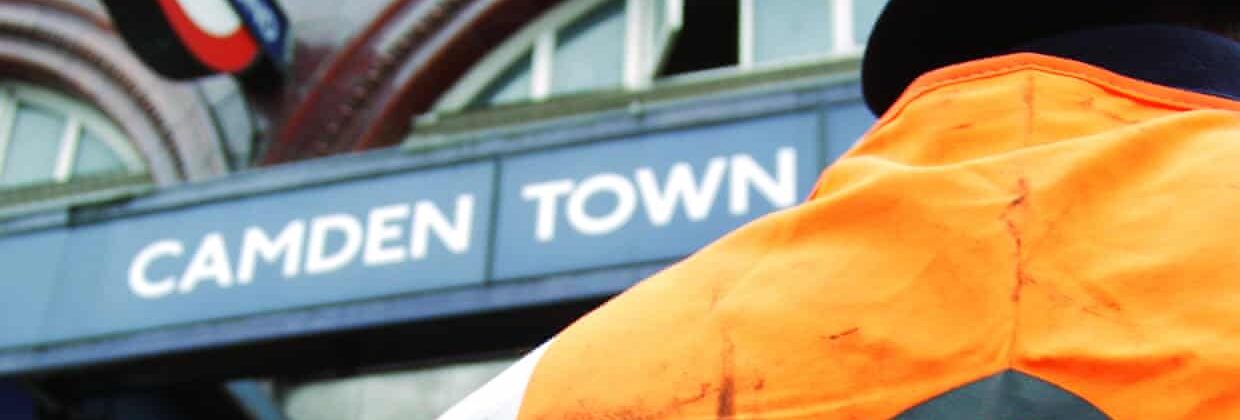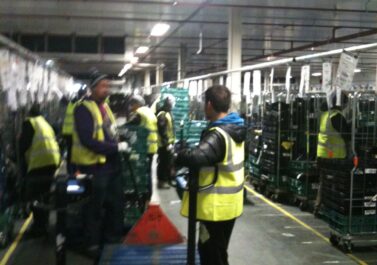First in a series of interviews, we have written about the idea behind these interviews here:
https://letsgetrooted.wordpress.com/2020/07/07/interview-series-workers-power-during-the-lockdown/
Workers’ power during the lockdown – A ‘Let’s get rooted’ interview series – Working on the London Underground – End of June 2020
We interviewed a friend who works on London Underground and is an RMT union rep about the situation during the Covid-19 lockdown at work. The interview shows that shorter working hours during the lockdown were at least partially enforced from below. We can see that the RMT provides a rank-and-file structure for workers, but is also tied up in the co-management of the transport network.
What happened when the Covid-19 pandemic started to become public knowledge? How did your co-workers talk about it? What did management do, health and safety or otherwise? Where people happy with that?
We had a driver at the beginning of March whose husband tested positive for the virus. We asked management what they are going to do about it, but they said: “Unless she tests positive we won’t do anything”. There was conflict with management about this. We were fighting them from January for PPE or some sort of health and safety plan. All the reps started emailing them when the pandemic started in January in China.
Was that mainly an initiative from the reps, or from workers too?
People started to get scared. Then, as usual, people start telling the reps to do something about it. It basically took management till the middle of May to get a regular supply of masks and hand sanitiser and stuff.
Did management intervene in the work process, did that change?
That changed, basically because of the lack of staff at work. Around 25 to 30 % of staff went off sick with symptoms. Passenger numbers went down by 95%, so straight away workers thought: “What’s the point? The more time I spend at work, the more dangerous it is for me”. Workers were only working four to five hour shifts and then went home. Drivers came to work, drive for three and a half hours and go home again. They had no breaks, they didn’t interact with many other staff. On a full-time schedule you have four meal breaks in different locations, you meet loads of people. None of that was going on. People felt safer because of that. Platform staff didn’t have to do the usual platform duties, they stopped manning the gates at the station entrance. Work was easier, less red signals, less passengers. Work was less stressful and days were shorter. The network managers in different locations reacted to people going home early differently. Some managers were amenable, others not. The five hours shifts later on got formalised across the entire network.
They can’t run a timetable if so many people are off sick and the remaining workers don’t want to risk their health. They had to more than half the number of trains during March and April. Initially they tried to stick to the timetable. But then it just descended into chaos if you have no drivers at the pick up points. It creates a chain reaction, as someone then has to drive the train to the depot. There were four days of utter chaos. This also created conflicts between the different depots. Workers in one depot thought that workers at the other didn’t work hard enough. People complained to the reps about this: “Hey, I saw seven drivers sitting around at depot so-and-so doing nothing”. They also come to the reps to get hand gel. There were actually negotiations going on and reps tried to equalise the workload between depots. The unequal work load is also due to the physical location of the depot.
So they could not run that timetable. Then they started an emergency timetable and then a ‘Covid 19’ timetable. They wanted to have trains running every 4 minutes. That would have meant longer hours and more mingling for workers at work. Drivers and reps rejected this timetable. Management then came to the union and said: “You reps can redesign this timetable a little bit and try and make it work. The industrial reps were released for a week. So yes, management relied on the union in that regard. The problem was that management rejected every proposal made by the reps. They tried to enforce their timetable, we rejected that. We threatened them with a ballot over it, that went to ACAS. Things dragged on. In the end, the 5-hour day continued for two months.
Did this include the cleaners?
Because they increased the amount of cleaning, the cleaners’ hours were not affected. The cleaners from the agencies were given full sick pay, under pressure from the union. They normally only get statutory sick pay. The argument was health and safety: if people don’t get full wages, they come in to work sick.
What happened when the official lockdown started?
When the lockdown started, people with health risks, for example because they have diabetes or are over a certain age, were sent home paid. This lasted for twelve weeks. Now the people are back at work. In the last two, three weeks they were contacting everyone telling them that it is now safe to come back to work. I don’t know how safe it actually is for them.
How did your co-workers relate to the whole situation?
Some have the attitude: “We have to keep these trains running, this is a national emergency. We are key workers”. They didn’t want to have any industrial strife. We were in the middle of our pay ballot, which we just cancelled. We were going to strike over pay. But the company said if you don’t accept the pay offer now we will withdraw it and the next offer will be less due to the money we will lose because of the corona virus. The decision to cancel the ballot and to accept the offer was top-down. There was no involvement from the rank-and-file. The NEC made the decision, which is supposed to be the democratic body of the union, but it’s only twelve people, and only one of them works on London Underground. Almost immediately after the crisis started, the union general secretary Mick Cash put a statement out, saying that this time it’s very important to work with the government.
Some people were really angry about the fact that they blackmailed us to accept the offer and that they didn’t have any PPE for us, no extra facilities to wash your hands. The actual social distancing they didn’t implement before May. It took them six, seven weeks to take chairs out of the mess rooms. That’s after the government announcement, which in itself was late. We had to make them do it, we had to tell them that you can’t have four chairs around a table. Drivers got angry and shouted at the managers. At one point they put up a perspex screen at the managers’ desk where we book on for work. Drivers said: “How come you got that screen, if you have no masks for us?”
Now feelings are bad, partly because of the pay blackmail, but also because they are forcing people back to work, while managers are able to work from home. Managers call workers who are shielding because they have asthma to tell them to return to work, while they themselves sit safe at home. Because it all happened so quickly and we as a union are so hamstrung, there is nothing that we can do quickly. We try to oppose things, but it takes you two months to get to a point where you can strike, because of postal ballots and everything.
Did the relationship with the public change during the lockdown?
Yes, there was a lot of antagonism and fear, especially after Belly Mujinga was spat at while working at Victoria station and died from corona. Staff are paranoid that they get attacked at best of times. People get more aggro because there is only a train every 20 minutes and they still want to get to work.
Do you know how the school closure affected workmates at home?
Because they are key workers they were offered key worker school care. They also brought in that if you couldn’t get childcare you could take special leave, as well. That was another thing that people were furloughed for.
How many people were furloughed in total?
Around 7,000 out of 30,000. Anyone who was off sick long-term before the virus was furloughed. And lot of back office staff, they wrapped up certain projects. Or people in increased risk categories. And people on training, because you can have only one person in the cab.
Now that we are coming out of lockdown, are there certain changes that management wants to keep in place?
During the last week management have asked the drivers to do overtime. At the moment tube drivers can’t do overtime. You need to have your two days off and you only work your 36 hours. That is an agreement that the union has in place. They suggested to us that drivers should do rest-day-working. Because many drivers are still off and the bail-out condition for London Underground was that they run a 100% service, they’re desperately trying to run all trains. They’re also trying to increase the number of trains on the line, supposedly to make social distancing easier. They also cancelled the night-tube and put these part-time workers full time on day-shifts. The other part of the bail-out is that they have to save money somehow. An obvious way to save money is to cut the night-tube.
On 14th of May management tried to make people return to work and work the old full-hours timetable instead of the five hours. This came because of the bail-out, not because of the government easing the social distancing restrictions, which came much later. Management said we have to go back to full work in order to run more trains in order to help passengers to practice social distancing. Some drivers refused to go back to full hours on grounds of health and safety. Drivers didn’t feel safe, because full-hours would mean being crammed in break rooms in different locations and so on.
There were 30 or 40 drivers who refused to go back to the old 8-hours timetable in May. They said that it was not safe to go back. But that wasn’t enough people, so management could just stop their pay. The union is always hamstrung legally. They cannot instruct someone to refuse to work on grounds of health and safety. Amongst the reps there was no unified position anyway. More than half of the reps probably thought, “let’s just get back to work”. People were angry, but at the same time they did not want the trains to stop running – what do you do in that situation?
They used the bail-out already to cut free travel for kids and increased the congestion charge. How else will they use it?
They’ve put two government lackeys on the TFL board now. They bailed out the railways, as well. All privatised railways. From the second weekend in March, the government guaranteed that they would not lose money. “Keep running trains, we will cover all your losses.” They were afraid that all the companies would just hand back their franchises. With TFL they let it run and run until that deadline date when TFL would have gone bankrupt – so it becomes a news story. With the private ones it wasn’t even a story. TFL could be portrayed as a disaster. TFL is quite big and powerful, as a public company, and they don’t like that.
They haven’t said yet what the other strings of the bailout are, they just said that TFL has to save money. People are terrified and those who have been at risk during Covid and have been furloughed now want to come back, because they are more afraid of losing their job than of getting sick. It also looks like passenger numbers are not getting back to normal any time soon.
In general people mainly talk about the situation at TFL, not in a wider social sense. As TFL workers you feel a bit shielded from the recession. The underground is very insular, people didn’t talk about or perhaps didn’t even hear about strikes in other places or countries.
What is the next test case to see if workers feel stronger or weaker after the lockdown?
We came up with a charter of a dozen health and safety and other Covid related demands. We told management that if they don’t meet these demands there will be a ballot. The demands came up through branch meetings. The branch meetings took place on Zoom. We have a weekly train-grade Zoom meeting, these used to be monthly meetings. Normally hardly anyone attends these meetings, somewhere in a basement in Kings Cross. Recently attendance grew from 6 people to 70 or 80 people. There was so much engagement that they started having it weekly. Some people who never turned up before started joining on Zoom. That became very useful to share information across the network. This is also how the charter came about, collected from different branches. It was handed over on 11th of June.
What about the BLM protests?
I was not at work much. I know that there were some RMT banners at the demos. At TFL there is of course this section of the white working class that says that they can’t get behind the cause because it says ‘Black Lives Matter’. We work with racists, no doubt, but they are very careful not to say anything. It’s socially unacceptable.



